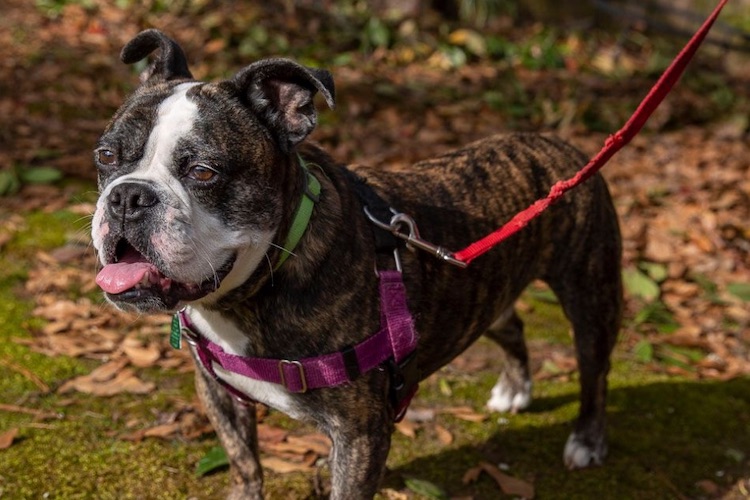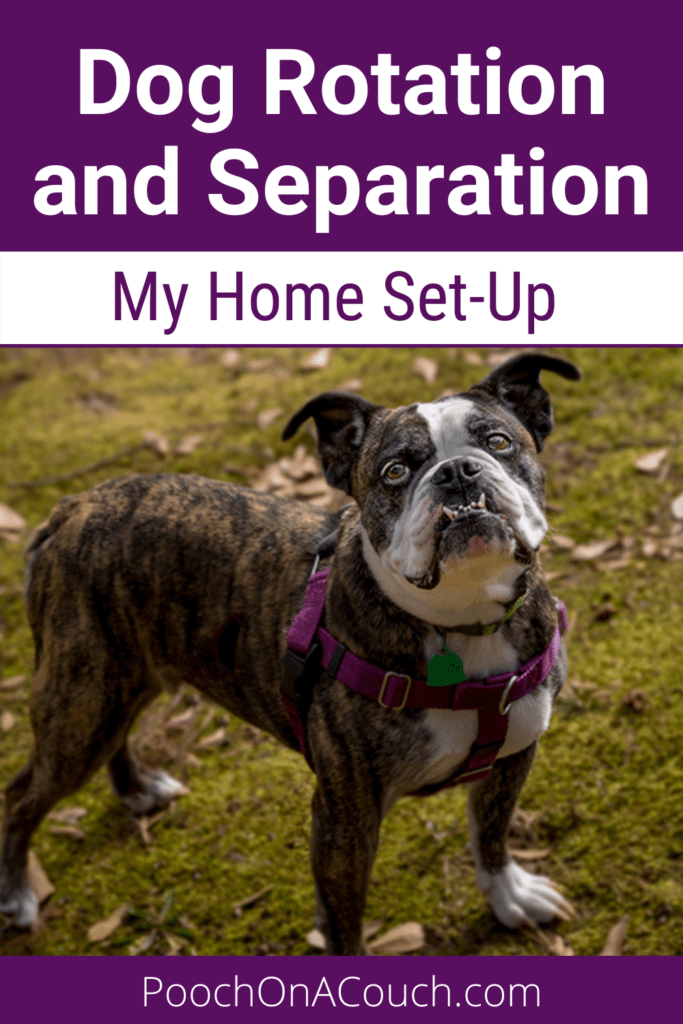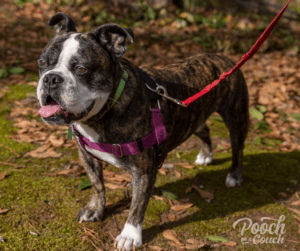Meet Sherlock! He’s a smooshable English Bulldog/Boston cross and I’m temporarily fostering him until we can find a more permanent foster placement. I’m looking for foster homes that know about dog rotation and separation. Do you know how?
Sherlock needs orthopedic surgery to repair a probable CCL tear or only a severely luxated patella, if he’s lucky. Right now, his primary need is to get used to having his freedom limited while we wait for his surgery date.
It’s been hard to find a permanent foster home for Sherlock. Is there really a shortage of individuals who have not learned how to “crate and rotate” nor have they taught the skill to their personal dogs?
Want to learn how?
Sherlock and my personal dogs take turns being out and about. For my dog Otis, this is a necessity early on since he is usually dog selective and can be a turd. It’s not fair to the foster dog and I don’t need to give Otis the opportunity to practice his rudeness.
For Sherlock, this is a necessity because he is facing twelve weeks of space restriction (confinement) post-op. He will need to be used to and content with being kept in an enclosure of some type until the surgeon releases him to resume normal activity.
If you foster dogs with any regularity you will find yourself needing to work dog rotation and separation into your daily routine. I’ll show you how!
Sherlock lives in my office, a 9′ x 10′ room. His crate is here, his food/water bowls are here, and his toys are here. He also has a cushy chair he can sit in. I gave him a big dog bed, but he promptly began to destroy it, so I took that out.
Since my office doesn’t have a proper door, I use a tall, walk-through baby gate. Sherlock appreciates this as it allows him to see through it.
If you are interested in learning the ins and outs of keeping dogs separate, learning how to rotate dogs, and keeping everyone happy in the process, read on – I’ll show you how I do it!
Study Your Home Space
In order to make dog separation and rotation work, you need to understand your home’s flow and the strategic placement of your confinement areas.
You’ve already done some of this work if you have crate area(s) set up for your personal dogs, but I encourage you to sketch out your home’s floor plan – don’t worry about exact measurements right now – you just need rooms and doorways.
My Floor Plan
Here is a crude layout of the social spaces in my home and where I place barriers to keep dogs separate and safe as I rotate dogs in and out of confinement.
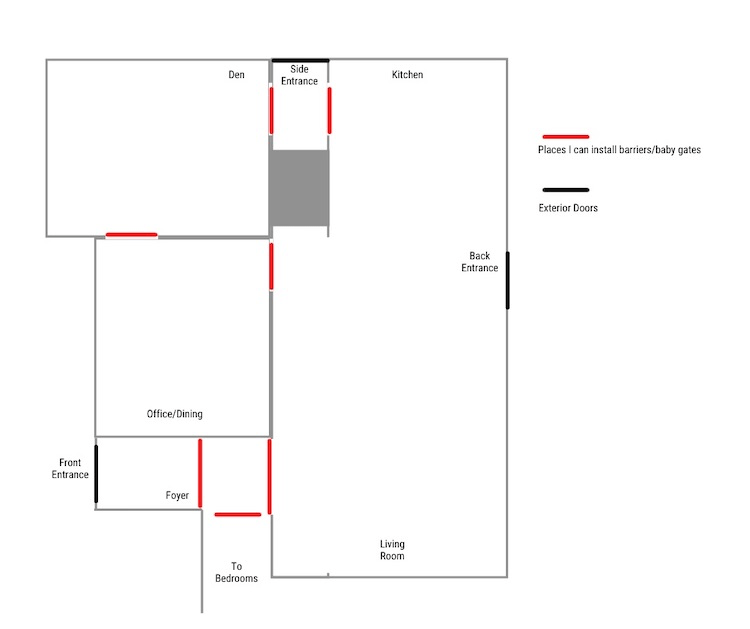
This configuration helps me easily rotate dogs!
Dogs in the den can easily be rotated to the living room by exiting the side door for potty time and coming in the back door. While they are outside, I can move the dog hanging in the living room or office into the den before allowing the dogs currently outside back indoors.
If I didn’t have a fenced back yard, I could still easily make the switch by using the office space, foyer, or even a bedroom as a temporary holding room while I make the switch.
How can you set up your home to have an easy flow for dog rotation and separation? Don’t forget about using garage spaces and outdoor deck spaces that have barriers to the yard. They serve as extra rooms.
Get Your Equipment Ready
To have a successful dog rotation and separation plan, you are going to have to have the right equipment. The basics include crates, baby gates, collars and leashes, and enrichment toys. For more on basic equipment, read here.
The more dogs you have, the more you are going to need to put your schedule to pen and paper.
3 Ways To Help Your Personal Pets Get Used to Dog Rotation and Separation
Your dogs matter! I want you to put their needs before any foster dog that comes into your home. That said, you can have happy personal pets that are willing to be part of your dog rotation and separation plan.
Do these three things to help your dogs become comfortable and flexible with rotation and separation:
1. Ask your dogs to practice hanging out in a separate room, either crated or loose.
Do this daily! I choose to do both; I need for my dogs to be able to be crated and be content there, no matter what is happening in the other rooms. I also want them to learn they can be free in a room without experiencing anxiety.
I crate or separate my dogs when my home is being serviced, when packages are being delivered to my door, when guests come over, or when I might be cooking with foods that are toxic to dogs.
I ask one of my dogs to crate or separate while I do training or games with the other one. Your dogs enjoy – and benefit from – individual time with you.
In the event that I have an unfamiliar foster dog, I know that my dogs are protected in their crates should that foster dog break loose from my handling.
2. Give your dogs something to do when they are separated.
Do they like to watch Animal Planet? Do they nap to soothing music? Do they like puzzle toys or stuffed Kongs? Make it easy for them to self-soothe. Include exercise in their daily routine.
Best toys for foster dogs
Gradually increase the time your dogs are asked to be separated. Have them practice even when you don’t have a foster dog in residence.
3. Have your dogs get used to you coming in and out of the room where they are separated.
Just because you come in the room doesn’t mean it’s time for them to move to a different space! You can acknowledge them and even give them a treat if you want, but you want to help them stay calm and relaxed as you move about.
This will cut down on the excitability and help your dogs practice being relaxed while in a crate.
Adding a Foster Dog Into Your Dog Rotation and Separation Schedule
When you can create a dog rotation and separation schedule, you can foster most any type of dog:
- dogs that need rest/recuperation from medical issues/surgery
- hospice dogs
- dogs needing quarantine
- nursing mama dogs
- heartworm-positive dogs
- dogs that aren’t house-trained
- dogs that are elopement risk
- dogs that have had a little spat and need a little time away from each other.
Tips For A Successful Rotation and Separation Schedule
- Use dog rotation and separation to introduce a foster dog to your household. You may only need to do this for a few days as part of your foster dog’s “decompression” period.
- Use potty times as perfect opportunities to switch out who has freedom and who is sequestered.
- Pay attention to your personal dog’s daily preferences. For example, my two dogs love to lay at the open front door on sunny days. Between the sunbeam and the glass from the storm door, they will lay there for a couple of hours. It’s a perfect time and place to pop up a baby gate and let them hang in the foyer while the foster dog has some freedom.
- Use larger chunks of time to break up the dog rotation schedule. Because I work at my desk in the office, Sherlock gets me most of the morning and part of the afternoon. My dogs move about the house during the day. In the evening, my dogs get me all to themselves – it’s snuggle time and movies. Sherlock gets a busy toy, and it isn’t long before he is snoring away.
- When appropriate, make sure all dogs have plenty of exercise. Some dogs can’t exercise for one reason or another. If you see that a foster dog is becoming frustrated with their confinement or activity restriction, talk with your veterinarian about ways to help your foster dog stay calm and anxiety-free.
And that’s it! Crate rotation and separation is doable with attention to detail, a good plan, and a wee bit of patience while your resident dogs get used to a new way of bringing home a foster dog. Could you implement this plan in your household? If you currently use crate rotation and separation, what increases your success? Where are you struggling? Drop me a line, I’d love to hear from you.
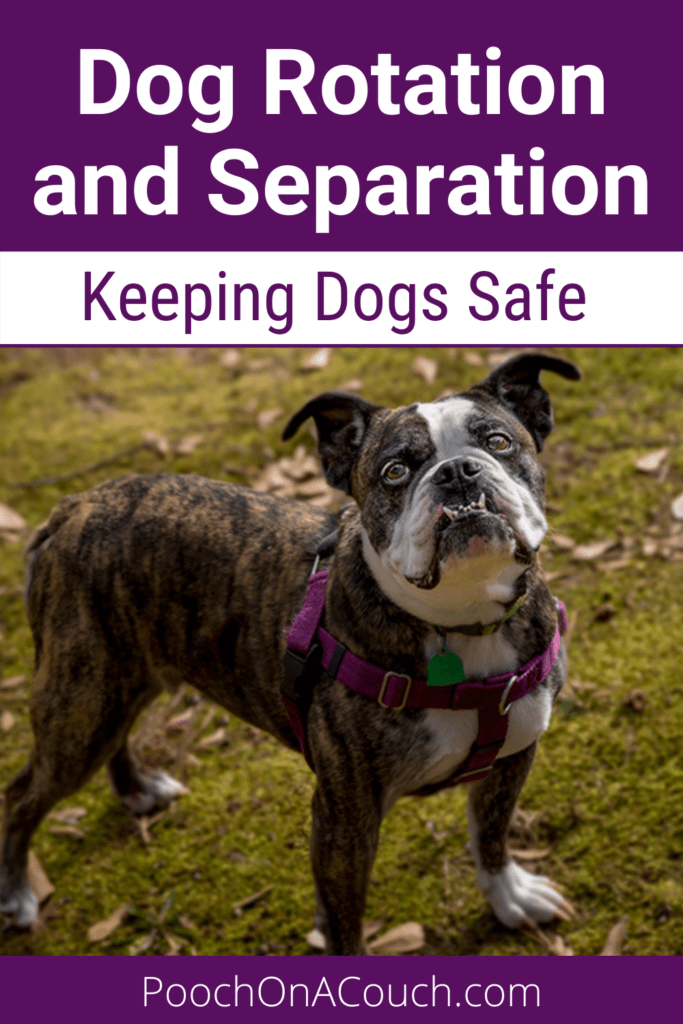
More Reading
Introducing A New Dog To Your Home
Leaving Two Dogs Alone For The First Time
Popular Posts
Prepare for Adoption Day
How To Choose A Rescue Agency (to volunteer)
The Ultimate Guide To Fostering Dogs

